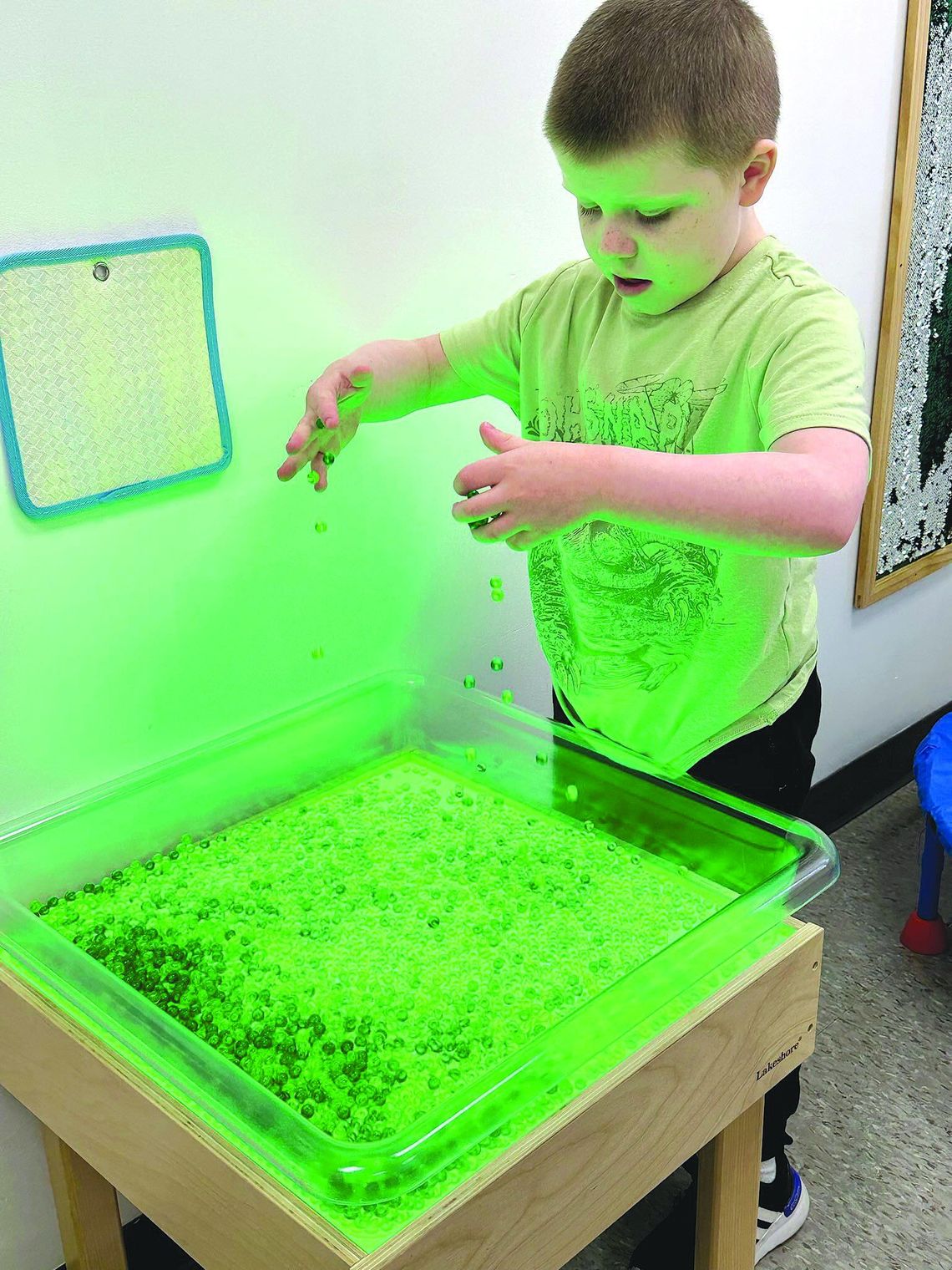Britton-Hecla School has a new specialized space. To the untrained eye, it might look like a fun little nook for students to play. There is a glowing light table, a glittery-looking sequin board, and even a swing in the middle of the room. Yet, according to B-H educators, this is not a playroom. It is a sensory room, and though it is new, it is already showing benefits serving some special students.
B-H special education teachers Brie Amacher and Rachelle Kilker explain the sensory room is largely for students who have sensory processing issues. These might include students with autism and attention-deficit/hyperactivity disorder (ADHD).
“Students may use things within this room to get the sensory input they are looking for,” said Amacher. She adds that a sensory room is a newer concept, and their use has increased in recent years as sensory processing disorders are becoming better understood.
According to the website National Autism Resources, sensory rooms can serve multiple purposes. They can promote self-organization, be a calming area, provide leisure, help with sensory integration, or act as skill training centers. The website emphasizes, “By controlling sensory input in the room it is possible to eliminate distractions and assist people to attend to specific objects that may help them make sense of their external environment.”
Certain B-H students have been spending time in the sensory room since it was developed in December. Kilker said that they received a donation for the project and started researching them more. Using special education resources and catalogs, various items for the room were purchased.
As noted, there are various hands-on items in the room, including tiles on the wall with different textures. There is a liquid mat that students can manipulate when they step on it. Kilker demonstrated how to use a thin sleeping bag-like cocoon in the room that some students benefit from.
There is a swing and even a mini trampoline. Amacher explains that these are particularly handy for students who get input from motion and swinging.
The teachers say they are still fine-tuning how to use the room, but so far, they bring students to it for short periods. “We might come for just five minutes to expend excess energy or lessen anxiety,” said Amacher. They might use the items in the room to practice language skills, or a few students might make use of the room together to practice sharing and social skills.
Kilker adds, “We don’t necessarily use it as a reward. It is generally our idea to use the room rather than the student’s and we usually set a timer when we come in here.”
Before the sensory room was in use, the teachers said that some of the equipment was in their regular classrooms. But they note that some of the items are quite bulky and could be distracting to other students when used. Consequently, having a separate room to use has been a great benefit.
B-H Elementary Principal and Special Education Director Kyla Richter is pleased to have this resource at their disposal. “The sensory room has been such a valuable addition to our school and serves a sensory input need for a population of our students,” she noted.
The admin also lauded her teachers who helped make this tool a reality. “The innovative special educators that we have in our district are always willing and eager to implement new tools for their students. The ideas they come up with are both thoughtful and impressive.”
Parents of students who have made use of the room are also pleased with its availability, including Erika Parrow. Parrow’s son Deagan is a first grader at B-H. He was diagnosed with Autism Spectrum Disorder (ASD) and Sensory Processing Disorder at age three. He has been receiving SPED services through the district since he began preschool.
Parrow said that the sensory room serves Deagan and his unique needs well. “When you have a child with a disability that hinders their basic life skills, such as being able to communicate verbally, there will be days that are tougher than others,” emphasized Parrow. “With Deagan, he can become frustrated very easily when he is trying to communicate simple wants and needs. This will sometimes result in a meltdown where his environment and all the stimuli within it causes him to become overstimulated and need a break. By having the sensory room available, it allows Deagan to have a safe place to go to help him learn how to cope and work through his frustrations and regulate his emotions so he can get back in the classroom with his peers and participate in activities. Some days, Deagan needs more frequent breaks, so having a quiet place is essential.”
Parrow added she is very pleased with Deagan’s educators and the school district. “When you have a child with a disability, sending them to school is very scary and stressful,” she noted. “We are very grateful that Deagan has an amazing team around him. It is reassuring to know as his mom that when he is having a hard day at school, his team is implementing the resources he needs to help him work through it and ensure he is not alone in doing so. As his family, it is comforting to know that when we cannot be there, his team always has his best interests at the forefront and work tirelessly to help him succeed to his best ability.”
As those hardworking B-H special educators look forward, they are excited to add more to the sensory room and their tool bag. Amacher and Kilker already have some additional items in mind that they feel their students could benefit from. They can also see ways that other students might make positive use of the room. In the future, the sensory room could be a great inclusion space that students can explore together.



